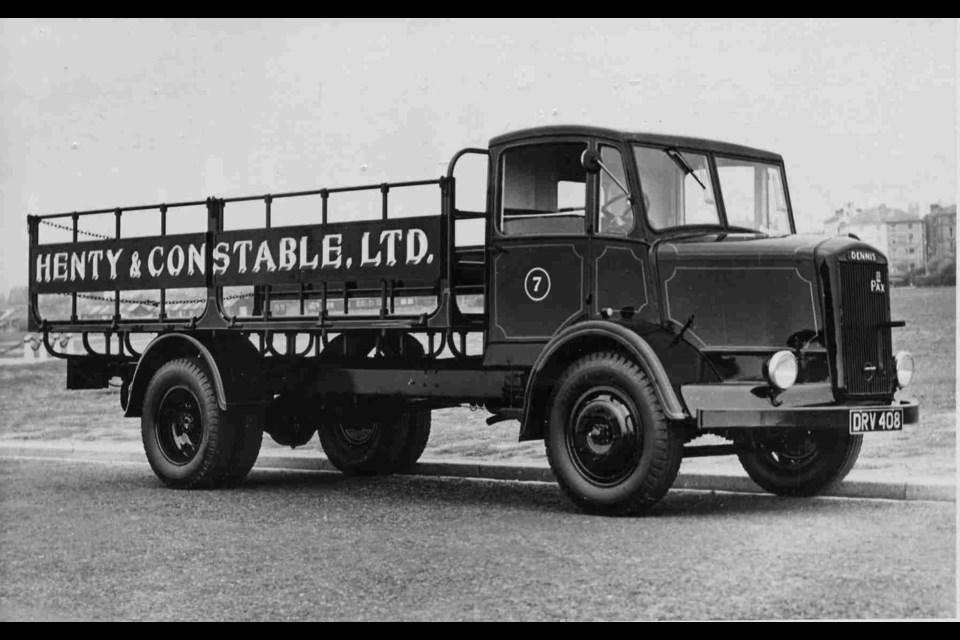Wars are fought by young men and young men (some of whom) like beer — a point not lost on Henty and Constable Brewing Company of Chichester, England. Immediately following the Normandy Invasion on June 6, 1944 Henty and Constable offered free beer to the troops in France. It was their way of saying thanks, quelling the thirst of British and Allied military personnel and doing their part in the war effort — not to mention recruiting future beer drinkers.
Unfortunately, logistics at the time were chaotic. Men and materials were pouring into France to fight the Nazis and wounded personnel and damaged equipment was being sent back to the UK. There was no obvious way to get beer across the English Channel to the struggling British and Allied troops and Air Force personnel.
Air Force aircrew and ground crew enjoy a beer as much as any soldier. The brilliant and thirsty minds of the Royal Air Force (RAF), Royal Canadian Air Force (RCAF) and the Polish and Norwegian Squadrons in the RAF put their heads together to solve the problem. What if the free beer could be flown to France from Southern England?
The RAF and squadrons of RCAF were flying as part of the Second Tactical Air Force. They initially flew out of South East England harassing Nazi troops and aircraft. After the invasion, and as the invading Allied forces succeeded and advanced further into France, the Tactical Air Force moved from England to temporary airfields called Advanced Landing Grounds (ALGs) in France. These temporary airfields were usually one runway made of square metal mesh that took about a week to lay down. New ALGs were built onward until existing Luftwaffe airfields were captured.
But servicing aircraft and official activities required Spitfires to return regularly to England on official business. Could RAF and RCAF Squadrons of the 2nd Tactical Air Force fly the beer from England to France following official visits to England?
The bold, innovative and thirsty Royal Air Force ground crews adapted two Spitfires and a couple of Typhoon for the ‘beer runs’.
They first had to adapt of wing pylons of the Spitfire Mk IX so the normal, extra fuel drop tanks could be filled with beer. The tanks were steam-cleaned and readied for beer. On the return flight from England to an Advanced Landing Ground the pilot was encouraged to go up to 12,000 feet so the beer could chill and be ready for consumption upon arrival.
The beer arrived cool, refreshing and tasting of aviation gas. There was no indication that the beer was thrown out but the steam-cleaning was not doing the trick. Av-fuel and beer is not a good combination.
Thirstyswagman (see above reference) wrote, “… a Spitfire from 416 Squadron, Royal Canadian Air Force, was flown from England to the newly built Bazenville airfield, only three miles from Gold Beach. It had a drop tank full of beer beneath its fuselage, and even though the tank had been cleaned out thoroughly with steam, unfortunately the beer still tasted of petrol.”
(In his book, “Dancing in the Skies”, Icelandic RAF Pilot Tony Jonsson, the only Icelandic Ace in the RAF in WW2, described flying beer across the Channel in a modified Spitfire.)
To be fair to the American Pilots the Fw190 looks a bit like a Hawker Typhoon
According to Thirstyswagman (see above reference) Polish Pilots and their Ground Crew of No. 131 Wing (Polish) figured out the problem of attaching two wooden beer barrels to the Spitfire Mk IX bomb racks. Having researched 303 RAF Squadron (Polish) and published their story, there is no doubt of the ingenuity of the Polish Air Force Ground Crews in exile.
By the late fall of 1944 the beer began flowing through ‘regular channels’. The NAAFI Service (Navy, Army, Air Force Institutes) took over transport and distribution and cross Channel flights ended.
One article suggested the British Customs and Excise people got involved and wanted export taxes. This was not confirmed.
As the troops moved forward and the campaign continued, RCAF fighter pilots saw fewer and fewer Luftwaffe aircraft. As such, Number 127 Wing, RCAF of the 2nd TAF, which included 403, 416 and 421 Squadrons focused more and more on vehicles; impeding troop movement and shooting up the enemy.
Photos used can be attributed to several sources, including Wikimedia
For a complete story of the beer carrying Spitfires please see: https://www.thirstyswagman.com/thirsty-news/the-beer-bombers-flying-pubs-of-ww2/




